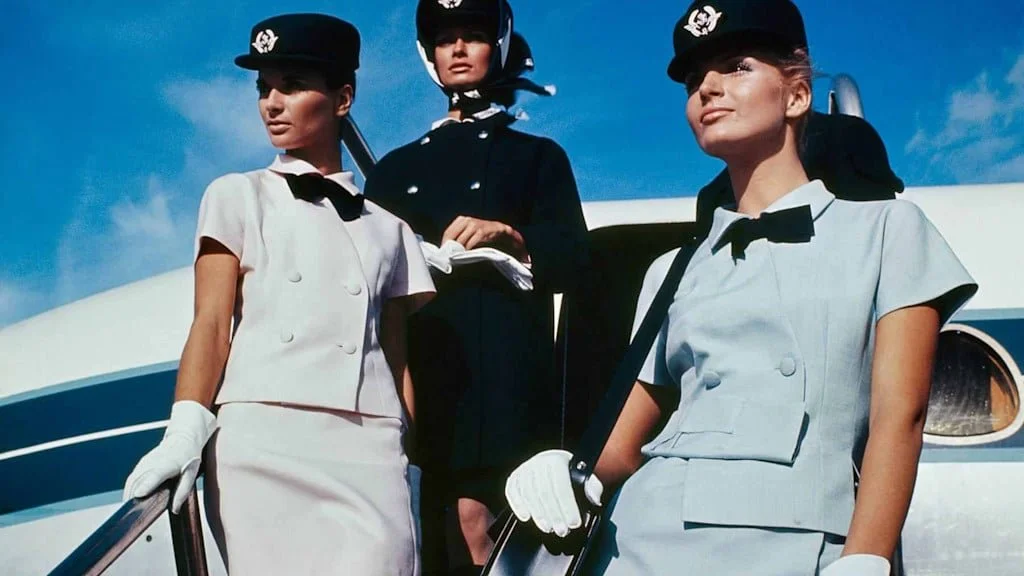Working the Runway: The Significance of Cabin Crew Uniforms
Words by Lydia Wilcox
eds. Mistral Zerbi
Picture yourself walking through any major airport in the world, what catches your eye? The duty-free zone, the window from which you can see planes taking off and landing to and from all corners of the globe, or the bright red cabin crew hat of the Emirates stewardesses as they rush by? The uniform of the Emirates stewardesses, and other stewardesses’ uniforms, are not only aesthetically pleasing, but hold a deeper significance. Stewardesses ensure the comfort, safety, and welfare of their passengers, but are also representative of both the countries and airlines they fly for.
Air travel was revolutionized in 1958 with the introduction of the jet passenger service. In the late 1950s and 1960s, flying was considered a luxurious experience. Pan American World Airways (Pan Am), which took to the skies with its first flight in 1927 and operated until 1991, arguably became the symbol of the golden age of air travel. Pan Am flights included cuisine crafted by world-renowned chefs, spacious cabins, experienced pilots, and stylish stewardesses. In a Financial Times article about Julia Cooke’s novel Come Fly the World, a novel that recounts the tales of former Pan Am stewardesses, journalist Peggy Hollinger states that “even in the 21st century, airlines continue to exploit the stereotype of sexually alluring stewardess to promote their business”. However, as quoted by Cooke, a former Pan Am flight attendant disagreed asserting, “I don’t think of myself as sex symbol…I think of myself as someone who knows how to open the door of a 747 in the dark, upside down, underwater”. The cabin crew uniform not only is a visual representation of the airline’s brand identity but also a symbol of the nation it serves cultural identity.
The most iconic cabin crew uniform is, undoubtedly, that of the Emirates’s cabin crew. Highlighting the diplomatic role of their cabin crew, Emirates refers to their stewardesses not as flight attendants but as ambassadors. As stated by Emirates, “the VIP Passenger Services uniform is designed in the shade of warm sand, symbolising the desert dunes of the United Arab Emirates…and an elegantly draped cream-coloured chiffon scarf, representing the local culture”. Emirates flight attendants serving premium and VIP passengers, who range from dignitaries and heads of state to members of royal families, have their own uniform that is different from the rest of the cabin crew. This reinforces Emirates’ belief that a stewardess’s role extends beyond providing basic hospitality.
Hainan Airlines, which is headquartered in Hainan, China, takes the style of its cabin crew very seriously. In 2017, Hainan Airlines commissioned designer Laurence Xu, a world-renowned designer whose work has been featured in both Paris Fashion Week and the Met Gala, to create their new uniforms. As with much of Xu’s work, the uniforms reflect a blend of Eastern and Western influences. According to an article from the BBC entitled “China’s Hainan Airlines: Coolest cabin crew uniform ever?”, Xu based the designs on the cheongsam, also known as qipao, but pairs it with Western-style capes and coats. Cheongsam, also known as qipao, is a style of dress that became popular in China at the end of the Qing Dynasty. The dress is typically long and figure-fitting with a standing collar. The garment is held together by frog fasteners. The uniform is adorned with sea mountains and clouds and features cool blue tones that are accented by vibrant red birds. Hainan Airlines described their cabin crew uniforms as “an element of the masterful visual experience,” which plays an integral role in shaping the overall Hainan experience for passengers.
When Air France first appointed flight attendants in 1946, they had no standard uniform. This inconsistency confused passengers, highlighting the importance of a recognizable uniform. This led Air France to introduce one designed by the Georgette Renal Fashion House. The uniform consisted of a petrol-blue suit, a poplin blouse, a summer dress, a felt beret adorned with a winged seahorse and a coat. These uniforms were supposed to resemble those of the military, a popular fashion trend in the post-war period. In the 1960s, Air France’s cabin crew uniforms evolved significantly from a rigid military style to one that prioritized elegance. In 1962, the House of Christian Dior was commissioned to revamp the garments, providing stewardesses with both a summer and winter uniform. As noted by Fajo, the “winter suit was in a blue braid. The jacket was short, with a Claudine collar revealing the collar of the white blouse. The pillbox hat, in sky blue or navy blue, was adorned with the Air France crest”. Over the years a number of acclaimed designers have created a line of iconic uniforms for the Air France cabin crew including Balenciaga and Lacroix.
Stewardesses are of vital importance to not only ensure the safety and wellbeing of their passengers, but also act as representatives of their airline and the country that it serves. The uniforms of the cabin crew serve the same purpose, representing their home country through vibrant and recognizable state colours or distinctive motifs.


